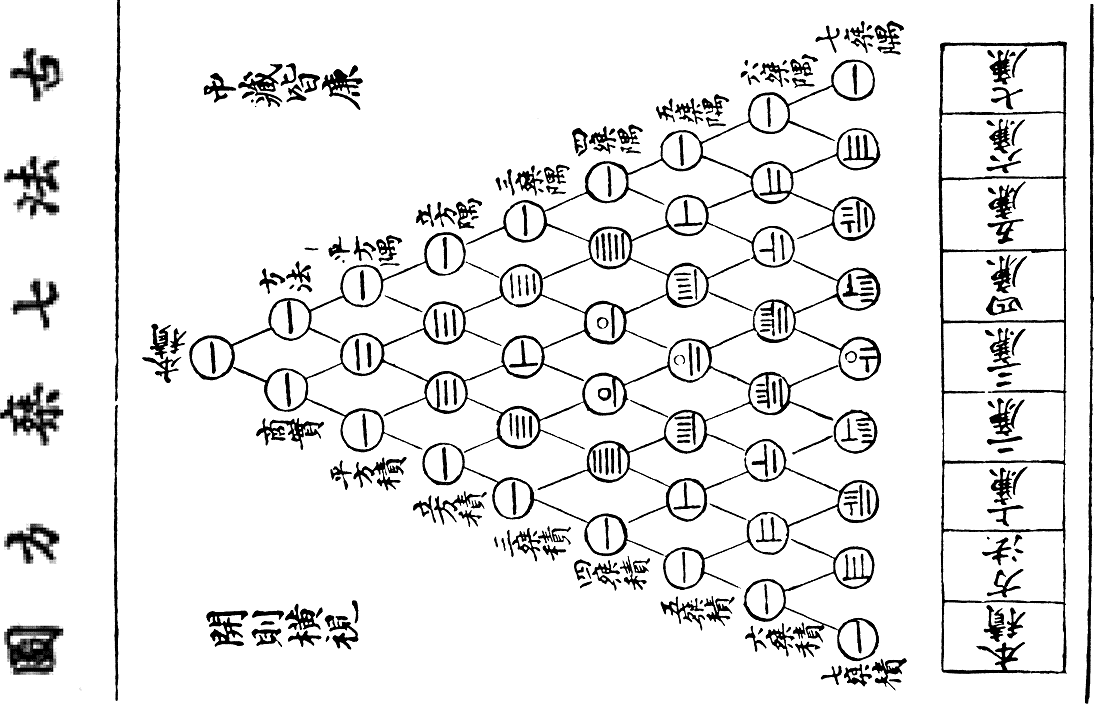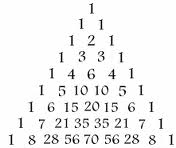- All but 10 of you have introduced
yourselves on Canvas. I'd like 100% of you to do so! Please
introduce yourself if you haven't yet (and you might go back
and meet some more. You're an interesting group!
- I've had several people email regarding the logo. The logo is due
at the end of the course, after you've learned a whole bunch of cool
math. So be patient for that!
But keep your eye out for math that resonates with you, and be thinking about what you might like to incorporate into your "family crest".
- There are three videos covering the material today (walking you through this page):
I hate to spoil the surprise by telling you exactly what it is -- many of you seem to have figured it out, and found the error in the chart.
Here are some key words and ideas, however:
- Symmetry -- the triangle is symmetric (which is one way of discovering the location of the error, by the way).
- Exponential growth -- We hear a lot about things growing "exponentially" these days -- mostly Covid numbers...:( -- however this has a technical definition in math; and, indeed, this artifact shows signs of it!
- Addition, of two numbers to make a third
- "repeated" -- do it again, do it again....
- Persistence: "The longer I look at this chart, the more I understand it."
- Looking at things from a different perspective
(literally!): "it started to make more sense when I
flipped it on its side."

- Restriction: try to figure it out using just the first few rows (restricting you attention helps you to see more clearly).
- Generalization: "consider a family tree"
Let's suppose it is. If we can figure out the number pattern, then we may be able to figure out how the "old Chinese symbols" work! We can use the mathematics to help us decipher a system of writing.
If you're an anthropology major, you may suddenly see the value in knowing a little mathematics...:)
If you know the mathematics, can you write the next row in the series, in both our numbers and in the writing of the Chinese scribe?
Many of you mentioned "sequence" -- it turns out that there are all kinds of numerical sequences represented in this table, and we'll study several of them. For example, I would wager that many of you noticed a sequence of repeating ones (along the two side diagonals).
Evan mentioned "a sequence found in nature" -- it turns out that one of nature's favorite sequences is concealed in this triangle. We will study it further on down the road.
But it's not a Chinese Christmas tree, Susan -- sorry to pass that sad news along to your third grader! Good idea to show things to kids, however: their brains are very flexible.
So: if it's not a Chinese Christmas tree, then what is it? Well, if you put it all together, you get a thing called "Pascal's triangle" -- let's take a look at that now.

- Different kinds of numbers appear in diagonals, which we should
all be able to identify:
- a line of 1s
- the counting numbers: 1, 2, 3, 4, ....
- The diagonals can be thought of as "accumulators": and
McKenna suggests a pattern for them: "...in each row the 1st
and 2nd symbols are added to create the new symbol in the
middle of the row beneath it. This is repeated in each row."
Counting is a critical step in probability, and the Pascal in "Pascal's Triangle" is Blaise Pascal (1623-1662), who studied it to help him compute probabilities:

The triangle was known long before Pascal, however: for example, YangHui's triangle is the 13th century Chinese version of our triangle; but that's not the oldest known version (the Indians probably knew of triangle as early as several hundred years BC).
One thing that Pascal's triangle allows us to do: it allows us to understand how this Chinese culture of the 13th century wrote its numbers (Chinese Bamboo Counting Rods). How did these people write 15? 28? 30?
I asked you to do the reading "From Fish to Infinity" for today, in which we learn the answer to one of life's persistent questions:
We learn something of that, anyway -- at least about six fish. But
We learn that
- "...numbers are shortcuts for counting by ones...." (p. 5)
- Furthermore, "...Humphrey might realize he can keep counting forever." (p. 5) -- something that will be very important when we come to talk about infinity.
Did you notice Humphrey using any other cues to help him keep track of the number of fish?
This leads us to your next reading: Rock Groups
fish fish fish fish fish fish
It turns out that the Great Fraudini can read anyone's mind -- so long as they're thinking of a number between 1 and 63, and they're willing to play a little card game with me. So let's see how this works....
- Rules of the game: you show the chump every card. If they see their number on it, they say "Yes"; otherwise they say "No". Then you tell them their number!
- Can you win at the game? (You should be able to do it every time!)
- Here's the handout for the cards, if you want to print off a copy. You need a set of cards to play!
So it turns out that the key can be found in Pascal's triangle! It seems that just about everything can be found there....
So in case you don't have a magic trick up your sleeve, I'm giving you one!
However I want you to think about it before I just give it away. Turn to your Fraudini discussion page on Canvas to make some conjectures, and guesses as to how I am (or rather how that Great Fraudini is) able to perform this magnificent trick!
(And try it out on some third graders, if you can! Let them figure it out....)
By the way, I always tell my students in MAT115 that gambling is foolish, unless you have inside information. So I'm all about giving you the inside information. But generally, and (in particular): "a lottery is a tax on people who are bad at math."

